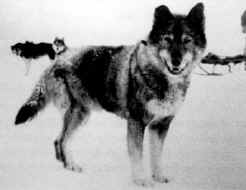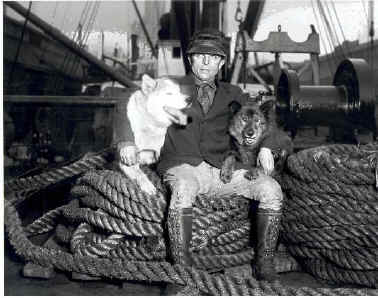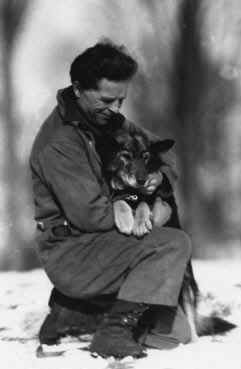By Lance Jensen
Leonhard Seppala.
The legendary Alaskan dog driver and Siberian Husky breeder. He would become
renowned as the greatest musher of the 20th century and would make significant
contributions to the establishment of the Siberian Husky breed in the USA.
Togo. A
Siberian Husky who initially was an unpromising pup, but would become Leonhard Seppala's
favorite and lead sled dog. Mr. Seppala would later say that Togo was "the best
dog that ever traveled the Alaskan trail" and "I never had a better dog than
Togo."
| Leonhard Seppala and Togo made many journeys together
in the land of Alaska. No doubt their greatest journey was as major participants in
the 1925 Serum Run to Nome. Togo died on December 5, 1929, at
the age of 16. His mount is currently on display at the Iditarod Trail Headquarters
in Wasilla, Alaska. Leonhard Seppala died on January 29, 1967, at the age of 89.
His ashes were placed along the Iditarod Trail near Knik, Alaska. The
distance between Knik and Wasilla is only about 15 miles. |

Togo, Seppala's
famous lead dog
Photo from
webmaster's collection
|
That would seem to be the end of the story.
But not so! After his death, Togo had one more journey to make. A
journey that would last for more than half a century. A journey that would
eventually reunite him with his beloved master in his native land. The place where
they had made so many journeys before, such a long time ago.
Trip Outside from Alaska in 1926
| During the
latter part of 1926, Leonhard Seppala brought a large group of dogs from Alaska to begin a
tour of the lower 48 states. Togo was in that group and
the tour started in Seattle, Washington.
[Editor's note: the tour eventually took Seppala and his
Siberian Huskies to New England for sled dog races where they were very successful.] |

Leonhard Seppala with Fritz, left, and Togo
Photo credit: Seattle
Post-Intelligencer Collection,
Museum of History & Industry, Seattle.
|
After completing the nationwide tour, Leonhard
Seppala established a Siberian Husky kennel in Poland Spring, Maine with Mrs. Elizabeth
Ricker. Mr. Seppala subsequently presented Togo to Mrs. Ricker, allowing him to live
out the rest of his life essentially in retirement.
Togo was in a bad way during the latter part of 1929.
He was now 16 years old and had been diagnosed with severe neuritis as well as skin
ailments. This once vibrant dog who had run thousands of miles during his life was
now suffering from severe mobility problems. He could barely stand and could only
walk a few steps.
Ralph Morrill came to the Peabody Museum of Natural
History at Yale University in 1924. He became the Chief Preparator in Zoology.

Farewell photo of
Leonhard Seppala and Togo,
taken by Ralph Morrill.
Photo courtesy of the
Peabody Museum of Natural History,
Yale University, New Haven, Connecticut, USA
|
|
During the late 1920's the Peabody museum was in the
process of establishing a rather large dog exhibit of famous champions. Arrangements had been made whereby Leonhard Seppala and Elizabeth Ricker
would donate Togo to the museum upon his death.
When the decision was made to end Togo's suffering, Mrs. Ricker
arranged so that Leonhard Seppala would have an opportunity to say goodbye to his old and
devoted companion.
Ralph Morrill was also present and he took a solemn and touching
farewell photo of Leonhard Seppala and Togo on December 5, 1929.
After that, Ralph Morrill took Togo to a veterinarian to be
euthanized and then to the Peabody Museum, where Togo would eventually join the other
famous dogs in the exhibit. |
Togo Among Champions at Peabody Museum
Almost a year
after Togo's death, on November 30, 1930, a public announcement was made advising that
Togo had joined the other dogs in the exhibit at the Peabody Museum. Ralph Morrill
later reported there had been some difficulty in completing the mount of Togo due to his
age and skin problems.
Togo received many visitors during his time at the
Peabody Museum. He would receive one very special visitor near the end of his stay
there. It would be from his master, Leonhard Seppala!
In early April of 1960, Leonhard Seppala, now in his
early eighties, traveled to Laconia, New Hampshire, to be the honorary judge of an annual
sled dog race. After this event he went to the Peabody Museum to see Togo.
Ralph Morrill was also present during this 30 year reunion and they reminisced about
Togo.
No doubt Leonhard Seppala was thinking about his last
reunion with Togo three decades earlier. Perhaps he was also thinking that as he was
in the autumn of his life, this would be the last time he would see his best dog.
But fate would decree that Leonhard Seppala and Togo would be reunited one more and final
time.
A few years after Leonhard Seppala's visit to Togo, the
Peabody Museum made the decision to permanently retire the dog collection. Ralph
Morrill knew all about Togo's history and didn't want him to end up in storage somewhere.
Togo's New Home at Shelburne Museum
In March of 1964
Ralph Morrill wrote a letter to Lorna Demidoff advising of the situation and asked her for
assistance in finding a new home for Togo. Lorna Demidoff agreed to help and took
possession of Togo in April. Mrs. Demidoff kept Togo in her garage for a time until
she was able to secure a new home for him. The Shelburne Museum in Shelburne,
Vermont, was selected and Togo was placed there in early May of 1964.
Togo had found a new home, but his troubles weren't
over. He had been on display for many years. Countless hands had touched and
petted him. As a result, his coat was threadbare in places and his tail was worn
down to the wire component of his mount.
In 1979 the Shelburne Museum had a new director, Ben
Mason. One of the staff asked the director to take "the raggedy dog" off
exhibit. The museum director agreed and placed Togo in storage, where he was
forgotten. Mr. Mason later admitted he was not aware of Togo's past and reputation
at that time. Togo seemed consigned to languish in storage.
Ed Blechner worked at the Shelburne Museum as a
carpenter. He also had a background in raising and racing sled dogs. One day,
he discovered a rather poor looking stuffed dog sitting on top of a refrigerator in a
storage building. Mr. Blechner was curious about this dog. After doing some
research, he learned that the stuffed dog was Togo.
Mr. Blechner informed the museum director of the
identity and heroic history of this dog. After hearing this, Ben Mason agreed that
they could not just leave Togo in storage. One of the things Ben Mason did was to
send word to some people in Alaska.
A Proper Final Resting Place for Togo - Where?
It didn't take
long for the news media to pick up the story. Soon the museum was flooded with
inquiries from Alaskan school children, members of both the Vermont and Alaska state
legislatures, dog clubs, museums, and various city officials. Most of them wanted
Togo returned to his native homeland. Other suggestions were also offered as to
Togo's disposition -- bury him where he had died in New England, do a taxidermic
workover, or create a separate museum for Togo.
The Shelburne Museum also received an inquiry from
Elizabeth Ricker who wanted to know what was going on with her dog. It was decided
that Mrs. Ricker no longer had any standing to claim ownership of Togo. This was
based, in part, on the fact that both she and Leonhard Seppala had agreed to donate Togo
to the Peabody Museum back in 1929.
Ben Mason agonized for several months over what was the
right thing to do with Togo. One of the offers received was from the Iditarod Trail
Committee based in Wasilla, Alaska. The proposal was that Togo would go to this
organization and they would either bury him beneath a monument honoring his
accomplishments, or display Togo at a proposed new museum. Mr. Mason liked this idea
best out of all the offers he had received.
On February 18, 1983, "The mounted Togo (catalog
number 38.2-2) was deaccessioned from the Shelburne Museum collection and was transferred
to the Iditarod Trail Committee (Wasilla, Alaska)." Ben Mason gave due credit
to Ed Blechner by saying "If there's one person who made all this happen, it's Ed
Blechner."
After more than 5 decades, Togo was finally on his way
back home!
Togo Back Home in Alaska
One of the first things that needed to be done with
Togo upon his arrival in Alaska was to have him refurbished. Dr. Bob Sept, DVM, was
the President of the Iditarod Trail Committee and was also a veterinarian for the Iditarod
race. Dr. Sept took Togo to Nelson's Taxidermy shop in Anchorage. Nelson
Stimaker was the owner and Joe Romero worked there. Togo would remain at the
taxidermy shop for a little over 2 years.
Togo's tail and ears definitely needed to be replaced.
A suitable donor would have to be found in order to accomplish this. One day,
a lady contacted Mr. Stimaker. Her dog had just died and she wanted the hide tanned
so that she could have a pair of fur gloves made. The shape, size and coloring of
the ears and tail of this dog was a good match for Togo. Mr. Stimaker asked this
lady if they could use the ears and tail of her dog on another dog, to which she agreed.
Joe Romero was assigned the task of doing a complete
taxidermic restoration and reconditioning of Togo. He also provided measurements for
a glass case. The glass case was subsequently ordered as the Iditarod Trail
Committee did not want Togo's condition to deteriorate again.
After the restoration process was completed, Togo went
to the Iditarod Trail Committee retail store at the Northway Mall in Anchorage, where he
was on display for a time.
Togo, Famous Distance Sled Dog, at Iditarod
Headquarters
After the Iditarod Trail Headquarters building in
Wasilla was completed in 1987, Togo was relocated there and has been on display, enclosed
in the glass case.
Togo's final journey -- marked by his arrival at the
Iditarod museum -- had lasted for more than 57 years. He had returned to his
homeland of Alaska and also to the same area where Leonhard Seppala had been laid to rest.
The team of the greatest musher and the best dog that
ever traveled the Alaskan trail had been reunited once again. And this time, it
would be forever.
Sources: Author Lance Jensen credits
the following as his major sources about Togo's final journey: The Peabody Museum at Yale
University, New Haven, Connecticut; the Shelburne Museum, Shelburne, Vermont; Ed Blechner;
Joe Romero; The Mushers Hall of Fame, JoAnne Potts, ITC; Seattle Times; Hartford
Courant, and New Haven Register. Thanks also to the Museum of History &
Industry or MOHAI, Seattle,
for photo use.
© Copyright 2007, Lance Jensen
About the Author:
Lance Jensen is a Siberian Husky fancier who is
interested in the early history of the breed in the U.S. He and his wife live in a
rural farming area of Oregon with their Siberians and Kuvasz. You can contact him
via email at: sibekuv @ msn.com [remove the spaces].
Other resources:
· Togo: entry in
Wikipedia
· Balto and Togo: guide from
WorkingDogWeb.com
· Photo of
Togo at Iditarod Headquarters, Wasilla, Alaska, included
on this blog page
· Headquarters
of the Iditarod Trail Sled Dog Race, Wasilla
· Togo
in Time magazine article, September 14, 1931, about the
Whitney collection of champion dogs, Peabody Museum of Natural
History, Yale University. [The article starts bottom of this page]
· Dog
Hall of Fame, established by Leon F. Whitney, DVM, at
the Yale Peabody
Museum as part of the Mammal Collections
· Leonhard
Seppala, a brief biography of the famous Alaska musher
from Norway
· Lorna
Demidoff, early Siberian Husky breeder and owner of
Monadnock Kennels
· Shelburne
Museum, Shelburne, Vermont
· Fritz,
another of Seppala's historic Siberian Husky, now displayed
at a Nome, Alaska, museum
· Siberian Husky World Online, guide
from WorkingDogWeb.com
.